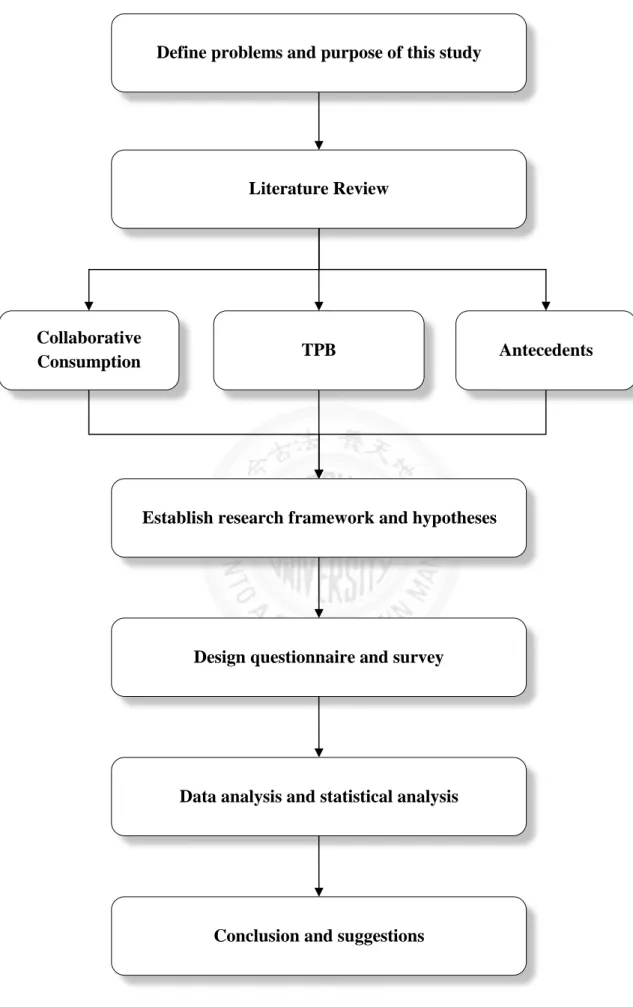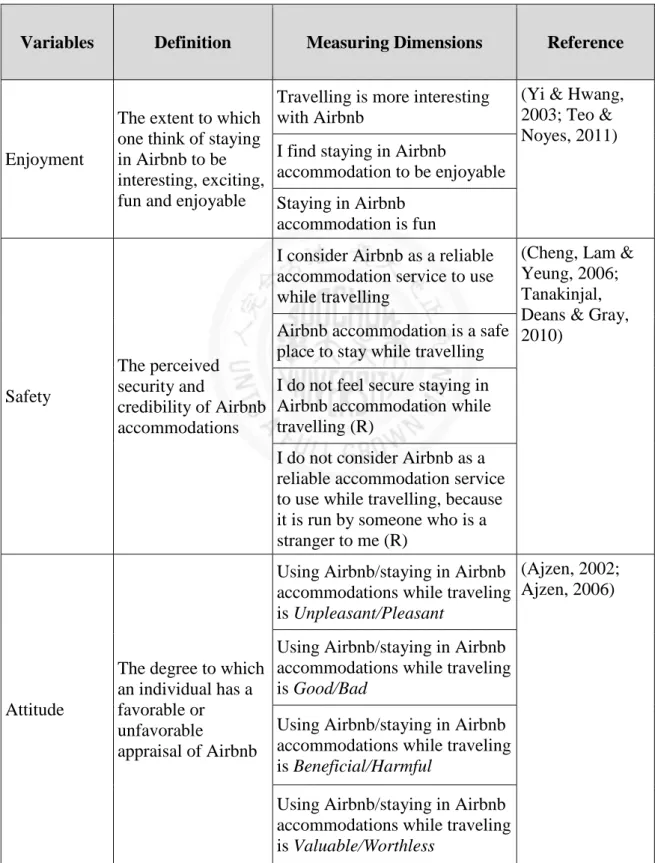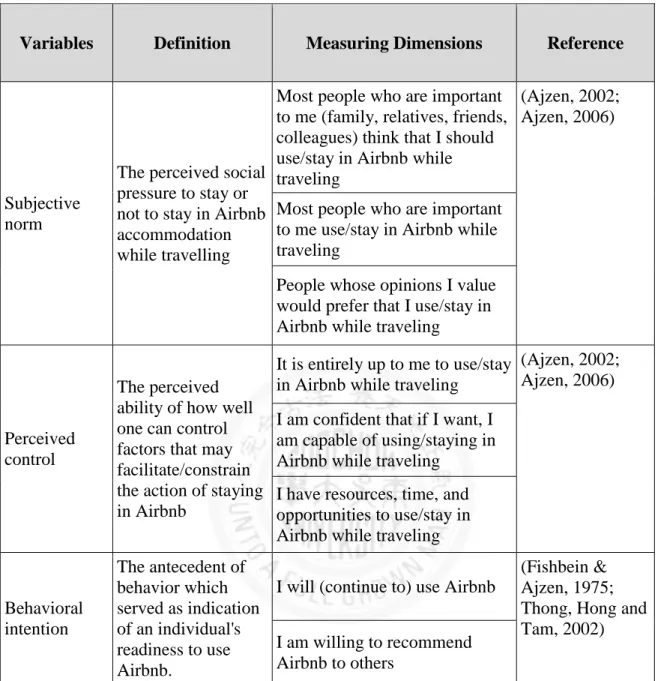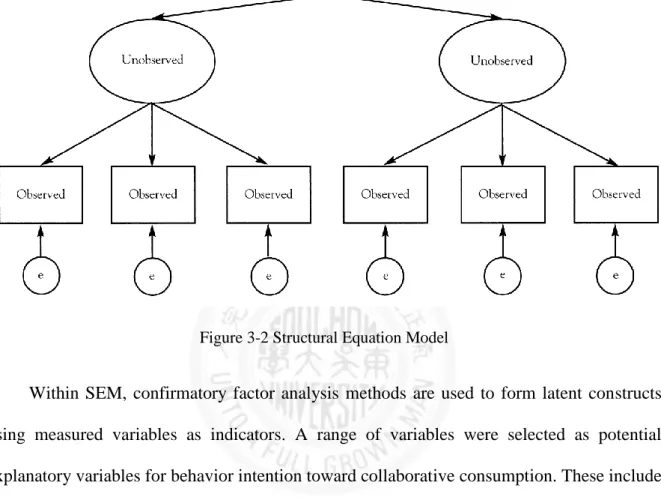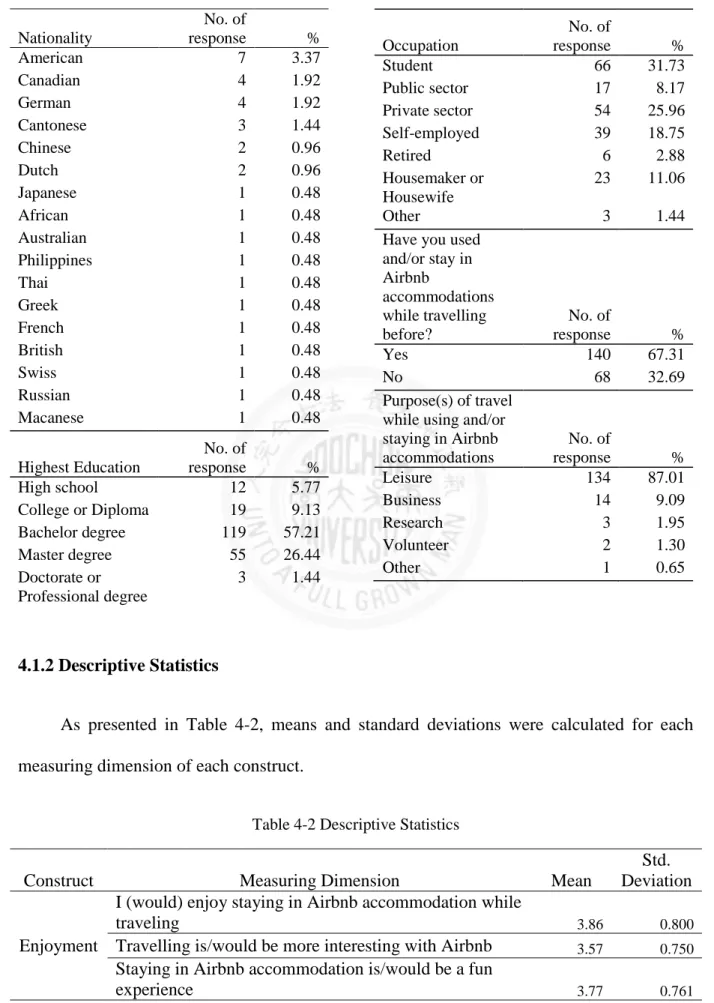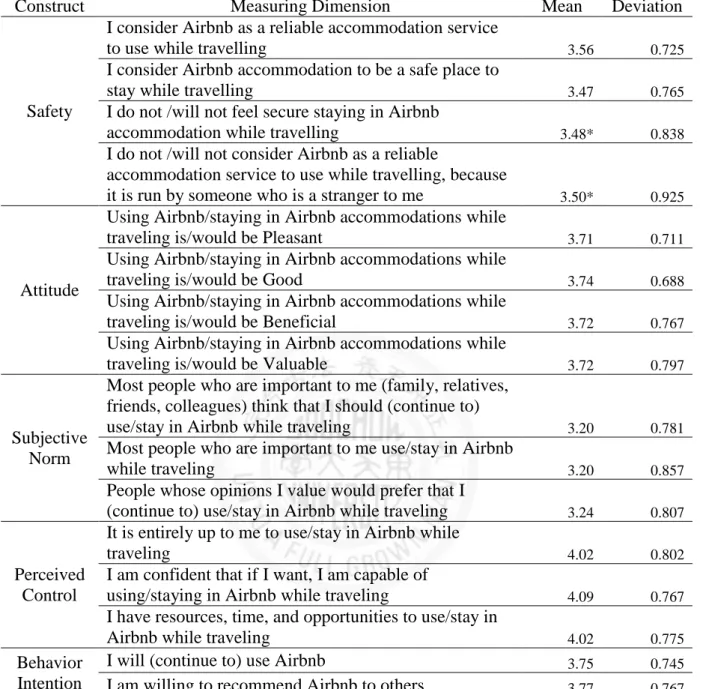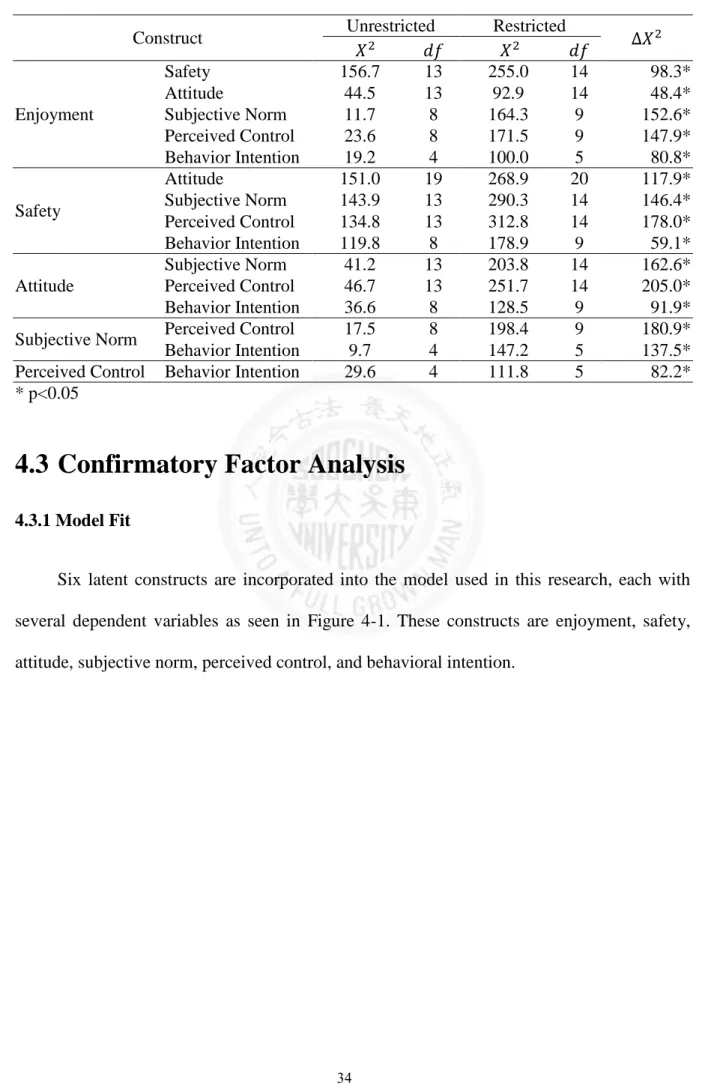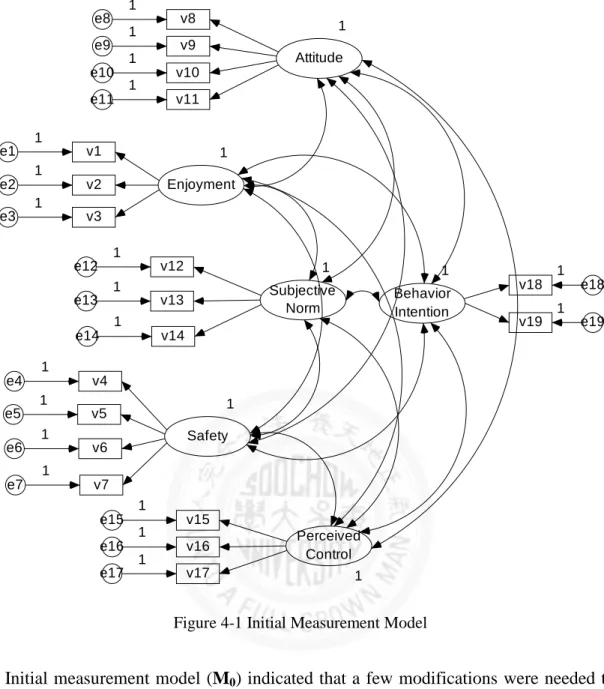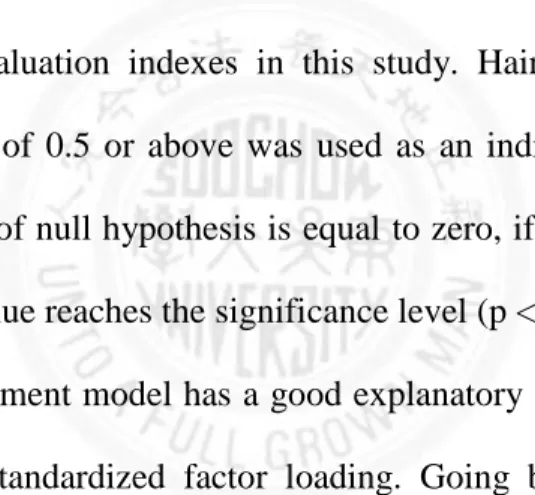Soochow University
Global Business Program, School of Business Thesis
Applying Theory of Planned Behavior to Explore the Antecedents of Behavior Intentions toward
Collaborative Consumption: Case of Airbnb
By Melvina Harsobisono 施惠瓊 Advisor: Prof. Hu, Kai-Chieh 胡凱傑 博士
January, 2018
Applying Theory of Planned Behavior to Explore the Antecedents of Behavior Intentions toward
Collaborative Consumption: Case of Airbnb
A Thesis Submitted to Soochow University
in partial Fulfillment of the Requirements for the Degree of
Master of Business Administration In
Global Business Program
By
Melvina Harsobisono
Global Business Program, School of Business, Soochow University January, 2018
Abstract
Collaborative consumption has been a rapidly-growing phenomenon in the last decade.
Fundamentally an act of sharing, it has been recognized to contribute positive benefits toward both the society and the environment. Nevertheless, few studies have been conducted to explore the determinants of engaging in collaborative consumption. The present study proposed and tested Ajzen’s Theory of Planned Behavior (TPB) to investigate the formation of an individual’s intentions to engage in collaborative consumption. In this study, Airbnb, one of the most prominent collaborative consumption platforms, was selected to represent collaborative consumption and participants’ behavior intention toward Airbnb was explored.
The influences of one’s enjoyment, feeling of safety, attitude, subjective norm, and perceived control on his/her behavior intention to collaborative consumption was investigated based on a total of 208 valid responses, which were tested and analyzed through structural equation modelling (SEM). Six hypotheses were proposed and results found that 1) enjoyment and safety positively influenced attitude toward collaborative consumption, 2) safety positively influenced perceived control toward collaborative consumption, and 3) attitude, subjective norm, and perceived control positively influenced behavior intention toward collaborative consumption. Putting emphasis on enhancing unique, authentic experiences and credibility of collaborative consumption hosts are some of the viable recommendations discussed in this study. Implication and suggestions for future research are discussed.
Keywords: collaborative consumption, sharing economy, Theory of Planned Behavior, behavior intention, enjoyment, safety, Airbnb, travel and accommodation.
Acknowledgement
First and foremost, I would like to express my deepest gratitude to my advisor Prof. Hu Kai-Chieh for his continuous guidance, patience, immense knowledge and support especially throughout the completion of this thesis. He was always within reach whenever I ran into a trouble or had a question about my research and writing, and steered me in the right direction whenever I needed it.
I would also like to thank Dr. Chang Hong-Sheng and Dr. Lu Ming-Ying who were involved in my thesis assessment, for their valuable suggestions and insightful comments toward this research. Without their inputs, this research could not have been this clear and complete.
I would also like to extend my most sincere appreciation to Serena Chiang, the secretary of Global Business Program (GBP) for her endless encouragement and assistance during my master study and research. I am gratefully indebted to her constant support throughout my time in GBP.
Finally, I must express my very profound gratitude to my parents for providing me with unfailing support and continuous encouragement throughout my years of study and through the process of researching and writing this thesis. This accomplishment would not have been possible without them. Thank you.
Table of Contents
Abstract ... i
Acknowledgement ... ii
Table of Contents ... iii
List of Figures ... v
List of Tables ... vi
CHAPTER 1 INTRODUCTION ... 1
1.1 Background and Motivation ... 1
1.2 Research Purpose ... 5
1.3 Research Scope ... 6
1.4 Research Process ... 6
CHAPTER 2 LITERATURE REVIEW ... 9
2.1 Collaborative Consumption ... 9
2.1.1 Sharing Economy ... 9
2.1.2 Collaborative Consumption ... 10
2.2 Theory of Planned Behavior ... 11
2.2.1 Basic Theory ... 11
2.2.2 Application ... 12
2.3 Enjoyment ... 14
2.3.1 Definition ... 14
2.3.2 Related studies ... 14
2.4 Safety ... 16
2.4.1 Definition ... 16
2.4.2 Related studies ... 16
CHAPTER 3 METHOD ... 18
3.1 Theoretical Model and Hypotheses ... 18
3.2 Measurements ... 21
3.2.1. Definition and Measurable Variables ... 21
3.2.2 Questionnaire Designing ... 24
3.3 Data Collection ... 25
3.4 Statistics Analysis Method ... 26
3.4.1 Theory construction of Structural Equation Modeling (SEM) ... 26
CHAPTER 4 RESULT ... 28
4.1 Sample Structure Analysis ... 28
4.1.1 Sample Structure ... 28
4.1.2 Descriptive Statistics ... 29
4.2 Reliability and Validity Analysis ... 32
4.2.1 Reliability Analysis ... 32
4.2.2 Validity Analysis ... 33
4.3 Confirmatory Factor Analysis ... 34
4.3.1 Model Fit ... 34
4.3.2 Measurement Model Analysis ... 37
4.4 Path Analysis ... 38
4.5 Direct and Indirect Effect... 41
CHAPTER 5 CONCLUSION AND RECOMMENDATION ... 43
5.1 Conclusion ... 43
5.2 Managerial Implication ... 45
5.3 Limitation and Suggestion ... 47
REFERENCES ... 49
APPENDIX ... 54
List of Figures
Figure 1-1 Research Process ... 8
Figure 3-1 Research Model ... 18
Figure 3-2 Structural Equation Model ... 27
Figure 4-1 Initial Measurement Model ... 35
Figure 4-2 Path Diagram ... 39
List of Tables
Table 3-1 Measured Variables ... 23
Table 4-1 Sample Structure ... 28
Table 4-2 Descriptive Statistics ... 29
Table 4-3 Reliability Analysis ... 33
Table 4-4 Discriminant Validity ... 34
Table 4-5 Initial Measurement Model Fitness Indices ... 36
Table 4-6 Measurement Model Fitness Indices after First Modification ... 36
Table 4-7 Measurement Model Fitness Indices after Second Modification ... 37
Table 4-8 Measurement Model Analysis ... 38
Table 4-9 Path Analysis Fitness Indices ... 40
Table 4-10 Path Analysis ... 41
CHAPTER 1 INTRODUCTION
1.1 Background and Motivation
An uneasy economy has made millennials cautious to spend money and accumulate more debt, but it has also brought forth new spending and consumption behaviors. A new mindset about consumerism has been established. According to Heller (2017) of The New Yorker Magazine, sharing and being frugal are now perceived as cool and clever as ownership is not a necessity anymore; for this generation, ownership can instead be an obstacle in terms of care and maintenance. This is why the sharing of goods and services made possible by the information technology has become essential (Arthursson, 2016). Gone are the days of "self-serving ownership"; community sharing, and "mass-enjoyment" are the 'now' trends.
While sharing is an act known to the society since far in the past, collaborative consumption and the sharing economy is a relatively new phenomenon that has been growing rapidly over the past decade (Frenken & Schor, 2017). Nevertheless, collaborative consumption is not as foreign of a concept as one might think. Especially in the U.S. where many collaborative consumption platforms such as Uber and Airbnb were founded, collaborative consumption has been referred to as part of the millennials’ economic future (Heller, 2017; Yaraghi & Ravi, 2017). In addition, it has also started to be a preferable choice adopt collaborative consumption in Europe and Asia too, specifically in accommodation and transportation sectors, as opposed to choosing taxis and traditional hotels (Wosskow, 2014;
Lee, 2016).
Sharing economy/collaborative consumption could offer a number of positive benefits towards a country’s economy. For Instance, before the emergence of sharing economy, only
hotel owners and big taxi companies could benefit from transportation and accommodation sectors in the past. However, along with the birth of collaborative consumption platforms like Uber and Airbnb, more entrepreneurship opportunities are available for local citizens to earn a living, by sharing their ownership of a property with others for a certain price.
Over the past few years, as society becomes increasingly exposed to technologies, collaborative consumption platforms emerge one after another transforming many sectors and industries. Founded in 2008 is one of the most prominent platforms to arise from the sharing economy, Airbnb; a collaborative consumption platform that allows people seeking for temporary accommodations to connect with others willing to rent out spaces in their homes (Interian, 2016). In a densely populated country like Indonesia, for instance, finding a land to build new properties is becoming harder and harder, and more than a few developers started to seek out forests and greeneries as a place for new hotels and resorts (Balch, 2015). Having more members of the society familiar with Airbnb could free up lands to be utilized for more environmentally-sustainable purposes, for instance, creating a green city.
According to Hamari, Sjöklint and Ukkonen (2015), growing concerns about environmental sustainability have made collaborative consumption an appealing alternative for consumers; it is considered to save natural resources and free up lands to allow reforesting.
Furthermore, an exploratory study by Tussyadiyah, 2015 suggests that collaborative consumption provides an opportunity for local communities to achieve economic benefits by utilizing unused resources in their possessions (e.g. cars and empty rooms). Therefore, it is important to explore the antecedents of consumer’s behavior intentions on sharing economy adoption, especially toward home-sharing services such as Airbnb. Not only it could provide financial opportunities for local community, but also save up free lands in a densely populated country for other purposes like promoting environmental sustainability.
In recent decades, people understand more and more about human behavior and the intentions that drive behaviors toward certain actions. In order to evaluate the behavioral intentions behind adoption of collaborative consumption, the Theory of Planned Behavior (TPB) will be utilize in the following study. While the Theory of Reasoned Action (TRA) solely focuses on volitional personal/social factors when explaining individual’s intention formation (Ajzen & Fishbein, 1980; Park, 2003), TPB, a more comprehensive version of the TRA, suggests that an individual’s intention to perform a certain behavior is determined by attitudes toward the behavior, subjective norms about engaging in the behavior, and perceptions on whether he/she will be able to successfully engage in the behavior (perceived control) (Ajzen, 1985, 1991, 2002). In particular, it could contribute to improving our prediction of an individual’s adoption intention to collaborative consumption.
The importance of TPB as a behavior predictor is apparent in studies investigating a wide range of behaviors, such as visit intentions to stay at a green hotel (Han, Hsu & Sheu, 2010), negative word-of-mouth (Cheng, Lam & Hsu, 2006), behavior intentions toward internet purchasing (George, 2004), experiencing local cuisine while travelling (Ryu & Jang, 2006), adolescent regular physical activity (Hamilton & White, 2008). This suggests that attitudes, subjective norm, and perceived control could also determine an individual’s behavior intentions toward collaborative consumption. With the increasingly popular collaborative consumption platforms like Airbnb, this study attempts to use TPB as its basis to explore the motivational factors that drives behavior intentions toward Airbnb. In other words, this study intents to investigate attitude, subjective norm, and perceived control as potential determinants of an individual’s behavior intention towards collaborative consumption.
The rise of collaborative consumption and its global recognition is driven and enabled by a number of factors. Among them, enjoyment and safety are two of the factors that have been continuously mentioned in a number of studies as drivers of collaborative consumption and other sharing-related activities. Studies suggest that enjoyment plays an essential role in the behavior intention towards collaborative consumption (Hamari et al., 2015; Guttentag, 2016). A survey of U.S. customers (Kokalitcheva, 2016; Verhage, 2016) indicates that many who had used Airbnb service would stick with it because they found their stay exciting and enjoyable. As proposed by Guttentag (2016), this enjoyment derives from the unique and authentic experience that one could gain from such sharing-economy practices like Airbnb.
As someone who have stayed in Airbnb accommodation several times in the past, I concur that it offers a unique staying experience compared to traditional hotels. Therefore, this study intents to investigate enjoyment as a potential determinant of an individual’s behavior intention towards collaborative consumption.
Nevertheless, adoption of collaborative consumption might also be exposed to a risk of safety. In April 2012, a Couchsurfing (a site that predates Airbnb) host was sentenced to six years in prison after he drugged and raped a 16-year-old Australian girl who was staying in his apartment with her sister and mother (Brown, 2015). Recent media attention has shown that guests of the Airbnb rentals have (1) been targets of crime, (2) had valuables stolen, and (3) may be more exposed to a greater range of crimes due to not being in a tourist location (Xu, Kim & Pennington-Gray, 2017). This suggests that while enjoyment could positively fuel the adoption of collaborative consumption, safety issue could be a big negative factor preventing people from adopting collaborative consumption. Therefore, this study intents to investigate safety as a potential determinant of an individual’s behavior intention towards collaborative consumption.
The impact of sharing economy has been enormous, affecting most dramatically, industries like accommodation, transportation, e-commerce, and tourism among others (Belk, 2014; Tussyadiyah, 2015; Lee, 2016). Despite a growing practical importance, there is a lack of studies exploring motivational factors that affect an individual’s attitudes and intentions towards collaborative consumption. By understanding the behavioral intentions behind the adoption of collaborative consumption, marketers and sharing-economy startups could better target their potential users; for instance, by promoting their effort on sustainability and/or addressing risks of safety so potential users would feel safe and protected. With more people adopting collaborative consumption, not only it will have positive effects on environmental sustainability, but hopefully also bring economic empowerment for local communities.
1.2 Research Purpose
This study intends to explore the motivational factors that drives people’s behavioral intentions towards collaborative consumption by utilizing Ajzen’s Theory of Planned Behavior (TPB). In particular, the effect of enjoyment and safety as factors that potentially drives one’s behavior toward collaborative consumption will be investigated in this study.
Here, a popular collaborative consumption platform offering accommodation-sharing services, Airbnb, will be used as a platform to represent collaborative consumption.
Specifically, this study aims to
1. Provide further understanding about collaborative consumption and its importance in the global economy
2. Examine enjoyment and safety as two of the motivational factors that drives people’s behavior intentions towards collaborative consumption
3. Explore the relationship between enjoyment, safety, and collaborative consumption through the use of Ajzen’s Theory of Planned Behavior (TPB) model.
4. Offer some insights on how to enhance people’s behavior intentions towards collaborative consumption
1.3 Research Scope
Among the increasingly popular collaborative consumption platforms in recent years, Airbnb was valued at $31B in 2016 (Overfelt, 2017). Since its launch in 2008, 115 million travelers have stayed in 3 million Airbnb listings in more than 191 countries (Airbnb, 2017).
Hence, this study will focus on behavior intentions towards Airbnb to represent collaborative consumption.
This study will mainly focus on investigating safety, enjoyment, attitude, subjective norm, and perceived control as potential antecedents toward collaborative consumption.
Airbnb will be observed as an accommodation sharing service, and will take little into account the effect of information technology and price.
1.4 Research Process
1. Define problems and purpose of this study
Explore problems and define the purpose and scope of this study according to the background and motivation.
2. Literature Review
Review literatures related to sharing economy and collaborative consumption, TPB model, Airbnb, and the antecedents of behavior intentions towards collaborative consumption.
3. Establish research framework and hypotheses
Establish research framework and hypotheses by applying TPB model to Airbnb.
4. Design questionnaire and Survey
Design questionnaire according to TPB model, targeted for those who may or may not have previous experience with Airbnb.
5. Data analysis and statistical analysis
Analyze the retrieved data and interpret findings with SEM method.
6. Conclusion and suggestions
Formulate conclusions and suggest implications regarding practices and methodologies based on the study and the information extracted from the questionnaire.
Figure 1-1 Research Process
Define problems and purpose of this study
Literature Review
Collaborative
Consumption TPB Antecedents
Establish research framework and hypotheses
Design questionnaire and survey
Data analysis and statistical analysis
Conclusion and suggestions
CHAPTER 2 LITERATURE REVIEW
2.1 Collaborative Consumption
2.1.1 Sharing Economy
The term "sharing economy" has been undeniably popular and extensively used in the past few decades. Although there are various definitions attached to it, at the core, it is an economic model in which individuals are able to borrow or rent assets owned by someone else. According to Erving (2014), the sharing economy is characterized by the ideas of collaboration and sharing to redistribute underutilized assets (Erving, 2014). Collaborative Consumption thought leader Rachel Botsman (2010), defines the sharing economy as “an economic model based on sharing underutilized assets from spaces to skills to stuff for monetary or non-monetary benefits”.
Sharing economy allows individuals and groups to make money from underused assets.
As Botsman (2010) says, the sharing economy is an economic model. This model runs on the principle that sharing resources such as time, space, and skills, is better for everyone involved.
For example, a car owner may allow someone to rent out her vehicle while she is not using it, or a condominium owner may rent out his condominium while he is on vacation. Both the owner and renter are favored in these situations, as the owner can utilize his/her unused asset and the renter could rent a car or condominium at a lower price.
The term especially comes under the spotlight recently when discussing about the economic future of the millennials. Millennials refer to those born after 1980 and the first generation to come of age in the new millennium. Based on the rapid growth of Uber and Airbnb, the sharing economy is estimated to grow from $14 billion in 2014 to $335 billion by 2025 (Wosskow, 2014). Especially in the U.S., many observers refer to sharing economy as
the new work model, so far as calling it the future of American work (Heller, 2017; Yaraghi
& Ravi, 2017).
2.1.2 Collaborative Consumption
Collaborative consumption emphasizes on one’s access to resources rather than ownership (Erving, 2014). Collaborative consumption is, at heart, a form of sharing.
Bartering and peer-to-peer renting, for example, have been used by societies for thousands of years and are a way to provide a group of individuals with an asset without requiring each to purchase it on his/her own. It is considered part of the sharing economy because it means that individuals are renting out their underused assets. It is most likely to be used when both the price of a particular asset, such as a car, is high and the asset is not utilized at all times (Botsman & Rogers, 2010; Belk, 2014).
According to Hamari, et al. (2015), collaborative consumption is a peer-to-peer-based activity of obtaining, giving, or sharing access to goods and services, coordinated through community-based online services. Based on this description and Botsman’s (2010) way of defining sharing economy, Airbnb is a good example – also one of the pioneers in the ever- growing business model – of collaborative consumption and sharing economy service.
Different from Online Travel Agency (OTA) like Hotels.com, Airbnb listings are made of accommodations owned by basic property owners rather than traditional hotels or professional accommodation services. Also different from traditional Bed and Breakfast (B&B), Airbnb accommodations do not have on-site staff that prepares breakfast, greets incoming guests and maintain B&B properties (Guttentag, 2016; Airbnb, 2018).
With a homepage that reads “Rent unique places to stay from local hosts in 190+
countries”, Airbnb is essentially an online community marketplace that connects people looking to rent out their homes with people who are looking for accommodations (Belk,
2014). It is in a form of a website that allows people to put their own living spaces up for rent much like a hotel. Airbnb and collaborative consumption has grown significantly in the last few years; Airbnb raised $1.5 billion in funds that brought the value of the company to about
$25.5 billion (Folger, 2016).
Another study shows that in seven U.S. cities, including New York, the percentage of Airbnb listings that fall in minority neighborhoods exceeds the percentage of hotel rooms that do; Locals were found to earn, on average, nearly six thousand dollars a year from Airbnb listings (Heller, 2017). Especially applies to the millennials, this illustrates how sharing economy is becoming a major part of the global economy. Hence, it is essential to get oneself proficient in the sharing-economy growth and why people participate in it.
2.2 Theory of Planned Behavior
2.2.1 Basic Theory
TPB (Ajzen, 1985, 1991) is an extension of the theory of reasoned action (TRA) (Ajzen and Fishbein, 1980) made necessary to account for the later model’s limitations in dealing with behaviors over which people have incomplete volitional control (Ajzen, 2002). It has been one of the most influential and popular conceptual framework in the study of human behaviors (Ajzen, 2001). At the center of TPB is the individual’s intention to perform a given behavior.
As mentioned briefly in Chapter 1, TPB, a more comprehensive version of the TRA, suggests that an individual’s intention to perform a certain behavior is determined by attitudes toward the behavior, subjective norms about engaging in the behavior, and perceptions on whether he/she will be able to successfully engage in the behavior (perceived control) (Ajzen, 1985, 1991, 2002). Attitude can be described as how favorable or
unfavorable an individual’s view or appraisal toward the behavior in question; Subjective norm refers to an individual’s perception of social pressure from significant others to perform or not to perform the behavior; Perceived control can be described as the perceived ease or difficulty of performing the behavior in question (Ajzen, 1991; 2002).
According to the theory (Ajzen, 1991, 2002; Conner & Armitage, 1998), an individual’s intention is driven by three kinds of determinants: beliefs about the likely consequences or other attributes of the behavior (behavioral beliefs) produce a favorable or unfavorable attitude toward the behavior; beliefs about the normative expectations of other people (normative beliefs) result in perceived social pressure or subjective norm; beliefs about the presence of factors that may further or hinder performance of the behavior (control beliefs) give rise to perceived control. Finally, an individual is expected to carry out their intentions when opportunity arises; thus, intention is assumed to be the immediate antecedent of an individual’s behavior. (Ajzen, 1991, 2002; Conner & Armitage, 1998, 2001).
2.2.2 Application
TPB with its strong predictive utility for a wide range of human actions, has been widely utilized to test and explain the formation of individuals’ intentions to perform a given behavior. A study by Han et al. (2009) proposed and tested Ajzen’s Theory of Planned Behavior (TPB) model to explain the formation of hotel customers’ intentions to visit a green hotel. The findings showed that TPB model has a good fit to the data and results revealed that attitude, subjective norm, and perceived control positively influence intention to stay at a green hotel.
In particular, study shows that attitude had a greater level of influence on intentions than subjective norm and perceived control, and also come to conclusion that paying more attention to ways to increase positive attitudes could be effective to increase visit intentions
to green hotel (Han et al., 2009). Attitude as a significant antecedent of behavior intention was also found in a study of tourist intention to experience local cuisine in a travel destination (Ryu & Jang, 2006). Another study on internet purchasing (George, 2004) also found a strong relationship between attitudes toward internet purchasing and the intentions toward the behavior itself.
A study on the role of social influences in predicting adolescent regular physical activity (Hamilton & White, 2008) found that subjective norm emerged as a significant predictor of adolescent intentions to engage in physical activity. This shows that adolescent intentions to engage in regular physical activity are more likely if they perceive that important referents think they should perform the behavior. Similarly, results of green hotel study by Han et al. (2009) also found subjective norm to significantly influence visit intention towards green property. Although not as strong as attitude, it was found that social pressure from significant others is likely to increase an individual’s visit intention.
The application of TPB was also apparent in another study by Schifter and Ajzen back in 1985 on weight loss. A basis of TPB was used to predict success at attempted weight reduction among college women. Intentions to lose weight were accurately predicted on the basis of attitudes, subjective norms, and perceived control. In particular, perceived control was found to be a great predictor of a successful weight loss; the women who believed that they had control over their body weight and were capable to lose weight were found to be most likely to succeed. In addition, although not as strong, Han et al. (2009) also found that perceived control is a significant antecedent towards behavior intention to visit a green property.
For the last few decades, TPB has been widely used on various behavioral research, explaining the science behind the formation of humans' behavioral intentions. Based on
TPB's strong predictive utility for human behaviors proven in numerous studies, including mentioned above, it is believed that TPB will provide more in-depth insights on the formation of people's intentions to adopt collaborative consumption.
2.3 Enjoyment
2.3.1 Definition
Activities are performed the longer without any tangible reward the more they are enjoyable (Lindenberg, 2001). That is the more they are simultaneously (i) stimulating (‘interesting’), (ii) providing comfort (absence of pressure from others), (iii) providing behavioral confirmation by self (‘free choice’ and ‘feeling of competence’), (iv) providing behavioral confirmation by others (positive feedback from others, (v) providing status (information on performance relative to others, (vi) allowing improvement of nontangible resources (such as skills and competencies). (Cameron and Pierce 1994; Tang and Hall 1995;
Eisenberger and Cameron 1996; Deci et al. 1999).
Research on motivational factors of collaborative consumption by Hamari et al. (2013) indicates that one enjoys certain activities when he/she regards them as fun, interesting, exciting and/or pleasant. Furthermore, a study on why tourists choose Airbnb (Guttentag, 2016) also suggests that one is likely take part in collaborative consumption simply because it is fun as it provides a more unique and authentic local experiences. This study will refer to the preceding definition to analyze enjoyment as an antecedent to one's intention of sharing economy adoption.
2.3.2 Related studies
Enjoyment has been regarded as an important factor in sharing-related activities in general. Studies indicate that information sharing on the internet, which has become a daily
habit and one distinctive characteristic of the millennials, is driven by the enjoyment gained from the said activity (Nov, 2007; Nov et al., 2010). In addition, Hamari et al. (2015) argue that enjoyment plays an essential role in attitude formation and use intentions.
Airbnb’s CEO claimed the service gives “travelers a new, authentic way to experience [a destination] by staying in different neighborhoods”, and another co-founder stated, “We’re not just a provider of accommodation, we’re a provider of experiences (Parry, 2014). With Airbnb, the potential for a more unique and authentic local experiences seem to be the main appeal as to why modern consumer society enjoys accommodation-sharing services (Ritzer, 2011; Guttentag, 2016). Ritzer (2011) argues that there is a growing resentment among some millennials with the increasing degrees of predictability and control in society. Building upon this idea, Ahuvia and Izberk-Bilgin (2011) find that this discontent is inspiring one to embrace high levels of variety and unpredictability, which are characteristics that well describe Airbnb and collaborative consumption in general.
Different from traditional hotel experience, Airbnb offers modern consumer embrace of authentic experiences that has been an occurring trend in the last few decades (Bosshart &
Frick, 2006). Different studies also show that tourists find it exciting to go to less popular destinations and seek authentic experiences (Kontogeorgopoulos, 2003; Conran, 2006; Week, 2012; Maitland 2013). In addition, a recent survey of 2,000 U.S. consumers (Kokalitcheva, 2016; Verhage, 2016) reveals that travelers seem to stick with accommodation-sharing services, as opposed to traditional hotel rooms, once they try them. Specifically, the survey found that 79% of consumers who hadn't used Airbnb or other "peer-to-peer lodging" sites prefer traditional hotels, but that number dropped by half to 40% for those who had, stating that they found their stay exciting, homely and enjoyable.
Based on studies mentioned, the growing desire of unique and authentic local experiences could be one of the main factors that fuels one’s enjoyment from Airbnb experiences. This further emphasizes that enjoyment could significantly influence one’s behavioral intention to participate in collaborative consumption, which will be explored in this study.
2.4 Safety
2.4.1 Definition
Sharing economy practices can raise multiple safety concerns. Among others are the credibility of drivers and house hosts, safety of vehicles and facilities, and location of houses and the position of neighbors (Ranchordás, 2014; 2015). Especially in an accommodation sharing service like Airbnb that involve staying overnight in a stranger’s place, criminal activities can often be unavoidable and unpredictable (e.g. Fox News, 2014; Brown, 2015).
While collaborative consumption wins the market with its lower cost and exciting experiences (Kokalitcheva, 2016; Verhage, 2016; Xu et al., 2017), safety issues could easily drive people away from adopting collaborative consumption and, hence, will be the main focus of this study.
2.4.2 Related studies
As suggested by Botsman and Rogers (2010), collaborative consumption implies trusting strangers to a varying degree. To use peer-to-peer accommodation is to believe that it is safe to spend some times at the guest room of a perfect stranger. According to a national consumer study in Minneapolis (PRNewswire, 2012), issues of trust shaped two thirds (67%) of consumers' perceived fears about participating in the sharing economy. Out of them, the
biggest barrier was concern of being a target of crime (30%), followed by worries about trusting the network (23%) and quality and location of goods/services (12%).
Ert, Fleischer, and Magen (2015) suggest that with Airbnb, and other collaborative consumption platforms likewise, one cannot know what to expect of the time he/she will be using the service (i.e. the time of staying in an Airbnb accommodation). As every step in the exchange process takes place online, people risk more than money which makes the issue of trust even more crucial (Botsman, 2012). Staying in a complete stranger’s house, or sharing a ride with someone we never met before, raises the question of safety.
Studies suggest that people who stay in accommodation-sharing homes not only serve as relatively easy targets for crimes, but may be more exposed to a greater range of crimes due to not being in a tourist location (Xu et al., 2017). The family of the 16-year-old girl who got raped by a Couchsurfing host thought that they could feel safe because the host was a cop.
Turned out he was a serial rapist that used Couchsurfing to lure women to his home (Brown, 2015). In addition, according to Eck (1994), people who take care of a lodging site such as janitors and apartment managers must be absent for a crime to occur on the site. In this regard, Airbnb accommodations will be more likely to attract crime offenders since they provide less supervision.
The issue about safety is extensively significant because one generally wants assurances that the services they are using are safe and trustworthy. Possibility of being a target of a crime could drive people away from engaging in sharing economy practices. Thus, this emphasizes how safety could significantly determine one's behavioral intention to participate in collaborative consumption.
CHAPTER 3 METHOD
3.1 Theoretical Model and Hypotheses
A total of six hypotheses, as seen in Figure 3-1, were derived based on research background, motivation, and literature review. These six hypotheses will be proposed and tested in this study.
Behavior Intentions Attitude
Subject norms
Perceived control Enjoyment
Safety
H1
H2
H3 H4
H5
H6
Figure 3-1 Research Model
According to previous research (Ajzen, 1991, 2002; Conner & Armitage, 1998), attitude, subject norms, and perceived control are the three constructs that play significant roles as direct determinants toward behavior intentions. A study investigating visit intentions to stay at a green hotel by Han et al. (2010) found that attitude, subjective norm, and perceived control have significant influences toward behavior intentions, consistent with other studies exploring behavior intentions toward internet purchasing (George, 2004), experiencing local cuisine while travelling (Ryu & Jang, 2006), regular physical activity (Hamilton & White, 2008). First of all, attitude toward a behavior is believed to have a positive influence on the concerned behavior. In other words, an individual’s positive attitude toward a certain behavior strengthens his/her intention to perform the behavior (Ajzen, 1991;
2002; 2006).
H1: Attitude has a positive influence on behavior intention towards collaborative consumption.
Second, subjective norm has been indicated to have positive influence on behavior intention particularly in studies of marketing and consumer behavior (Baker, Al-Gahtani, &
Hubona, 2007; Cheng et al., 2006; Lee, 2005). It indicates the probability of whether significant referents would approve or disapprove the concerned behavior (Ajzen, 1991).
Thus, in the context of this study, when family, friends, colleagues think staying in Airbnb accommodation while travelling is a proper behavior, one’s perceived social pressure to stay in Airbnb would increase with his/her motivation to comply.
H2: Subjective norm has a positive influence on behavior intention towards collaborative consumption.
Lastly, a number of studies have shown that an individual’s intention is positively influence by confidence in one’s ability to perform the behavior (Han et al., 2010; Baker et al., 2007; Cheng et al., 2006). Findings in these studies imply that when an individual holds little control over carrying out a certain behavior, his/her behavioral intention will be lower in spite of the fact that he/she has positive attitude/subjective norm concerning the intended act.
Therefore, the following three hypotheses are proposed:
H3: Perceived control has a positive influence on behavior intention towards collaborative consumption.
In the context of this study, the more enjoyment an individual (perceived to) gain by staying in Airbnb accommodation while travelling, the more favorable his/her attitude of the behavior intention toward Airbnb and collaborative consumption is expected to be. Research on motivational factors of collaborative consumption by Hamari et al. (2013) indicates that
one enjoys certain activities when he/she regards them as fun, interesting, exciting and/or pleasant. Moreover, a study on why tourists choose Airbnb (Guttentag, 2016) also suggests that one views taking part in collaborative consumption as interesting and exciting because it provides a more unique and authentic local experiences. Hence, it is hypothesized that enjoyment will fuel one’s behavior intention toward Airbnb and collaborative consumption.
H4: Enjoyment has a positive influence on attitude towards collaborative consumption.
As mentioned in literature review, safety issue has been one of tourists’ major concerns when deciding to use Airbnb while travelling. More than a few negative experiences have been reported as a result of the unavoidability of meeting un-trustable hosts and/or low security accommodations (Eck, 1994; Brown, 2015; Xu et al., 2017). Another study on perceived security in attitude and loyalty towards Airbnb (Yang & Ahn, 2016) correspondingly shows perceived security being a significantly powerful antecedent of attitude towards Airbnb. Thus, it is predicted that the higher one’s perceived safety towards Airbnb, the more positive his/her appraisal of behavior intention toward Airbnb and collaborative consumption.
H5: Safety has a positive influence on attitude towards collaborative consumption.
In addition, safety issue brings out more uncontrollable factors that may constrain an individual’s intention on staying in Airbnb accommodations while travelling, as well as adoption of collaborative consumption in general. A study by PRNewswire (2012) reveals that two thirds of participants are reluctant to stay in accommodation-sharing homes because they do not want to face the unpredictable and uncontrollable issues of being a target of crimes. Likewise, Ert et al. (2016) also mentions the risk of not knowing what to expect at the time of using the service in question. Therefore, the following hypothesis is proposed.
H6: Safety has a positive influence on perceived control towards collaborative consumption.
3.2 Measurements
3.2.1. Definition and Measurable Variables
In accordance to literature review and research framework, following are the six constructs that drives people’s behavior towards Airbnb, in particular, and collaborative consumption in general:
1. Enjoyment
For the purpose of this study, enjoyment is described as the extent to which an action done without any intangible rewards is regarded as fun, continuously stimulating (“interesting”), exciting and/or pleasant (Lindenberg, 2001; Hamari et al., 2013). In the context of collaborative consumption, it is the extent to which one think of staying in Airbnb to be interesting, exciting, fun and enjoyable. Enjoyment will be measured by measuring dimensions adapted from Yi and Hwang (2003) and Teo and Noyes (2011) as shown in Table 3-1.
2. Safety
Safety can be described as the degree to which an individual can feel safe performing the concerned behavior. In particular, it refers to the perceived security and credibility of the party offering sharing-economy services (Ranchordás, 2015). In the context of this study, it is the perceived security and credibility of Airbnb accommodations. Safety will be measured by measuring dimensions adapted from Cheng, Lam and Yeung (2006) and Tanakinjal, Deans and Gray (2010) as shown in Table 3-1.
3. Attitude
Attitude can be described as how favorable or unfavorable an individual’s view or appraisal toward the behavior in question (Ajzen, 1991, 2002), which in this case is the degree to which an individual has a favorable or unfavorable appraisal of Airbnb.
Attitude will be measured by measuring dimensions adapted from Ajzen (2002; 2006) as shown in Table 3-1.
4. Subjective norm
Subjective norm refers to an individual’s perception of social pressure from significant others to perform or not to perform the behavior (Ajzen, 1991, 2002). Particularly in this study, it is the perceived social pressure to stay or not to stay in Airbnb accommodation while travelling. Subjective norm will be measured by measuring dimensions adapted from Ajzen (2002; 2006) as shown in Table 3-1.
5. Perceived control
Perceived control can be described as the perceived ease or difficulty of performing the behavior in question (Ajzen, 1991). In particular, perceived control measures an individual’s perception of how well he/she can control factors that may facilitate/constrain the actions needed to deal with a specific situation concerning the behavior (Ajzen, 2006; Han et al., 2010), which for this study is the action of staying in Airbnb. Perceived control will be measured by measuring dimensions adapted from Ajzen (2002; 2006) as shown in Table 3-1.
6. Behavior intention
Ajzen (1991; 2002) describes behavior intention as the antecedent of a certain behavior;
it serves as an indication of one’s readiness to execute an action corresponding to the concerned behavior. The readiness to adopt collaborative consumption, and Airbnb in
particular, is the concerned behavior in this study. Behavior intention will be measured by measuring dimensions adapted from Fishbein & Ajzen (1975) Thong, Hong and Tam (2002) as shown in Table 3-1.
Table 3-1Measured Variables
Variables Definition Measuring Dimensions Reference
Enjoyment
The extent to which one think of staying in Airbnb to be interesting, exciting, fun and enjoyable
Travelling is more interesting with Airbnb
(Yi & Hwang, 2003; Teo &
Noyes, 2011) I find staying in Airbnb
accommodation to be enjoyable Staying in Airbnb
accommodation is fun
Safety
The perceived security and
credibility of Airbnb accommodations
I consider Airbnb as a reliable accommodation service to use while travelling
(Cheng, Lam &
Yeung, 2006;
Tanakinjal, Deans & Gray, 2010)
Airbnb accommodation is a safe place to stay while travelling I do not feel secure staying in Airbnb accommodation while travelling (R)
I do not consider Airbnb as a reliable accommodation service to use while travelling, because it is run by someone who is a stranger to me (R)
Attitude
The degree to which an individual has a favorable or unfavorable
appraisal of Airbnb
Using Airbnb/staying in Airbnb accommodations while traveling is Unpleasant/Pleasant
(Ajzen, 2002;
Ajzen, 2006)
Using Airbnb/staying in Airbnb accommodations while traveling is Good/Bad
Using Airbnb/staying in Airbnb accommodations while traveling is Beneficial/Harmful
Using Airbnb/staying in Airbnb accommodations while traveling is Valuable/Worthless
Table 3-2Measured Variables (cont.)
Variables Definition Measuring Dimensions Reference
Subjective norm
The perceived social pressure to stay or not to stay in Airbnb accommodation while travelling
Most people who are important to me (family, relatives, friends, colleagues) think that I should use/stay in Airbnb while traveling
(Ajzen, 2002;
Ajzen, 2006)
Most people who are important to me use/stay in Airbnb while traveling
People whose opinions I value would prefer that I use/stay in Airbnb while traveling
Perceived control
The perceived ability of how well one can control factors that may facilitate/constrain the action of staying in Airbnb
It is entirely up to me to use/stay in Airbnb while traveling
(Ajzen, 2002;
Ajzen, 2006) I am confident that if I want, I
am capable of using/staying in Airbnb while traveling
I have resources, time, and opportunities to use/stay in Airbnb while traveling
Behavioral intention
The antecedent of behavior which served as indication of an individual's readiness to use Airbnb.
I will (continue to) use Airbnb
(Fishbein &
Ajzen, 1975;
Thong, Hong and Tam, 2002) I am willing to recommend
Airbnb to others
3.2.2 Questionnaire Designing
For the purpose of this study, the questionnaire will be divided into three main sections.
First section focuses on external factors: enjoyment (four questions) and safety (four questions). Second section focuses on internal factors: attitude (five questions), subjective norm (three questions), and perceived control (three questions). Last section focuses on one’s behavioral intention (two questions). A five-point Likert scale, numeric values ranging from 1 to 5 (strongly disagree to strongly agree) is adopted in this study.
3.3 Data Collection
Airbnb reports that approximately 40% of its guests are American, with Europeans comprising the majority of the rest, with an average age of 35 (Guttentag, 2015). With the largely diverse background of Airbnb users, this study will be targeted to respondents with any nationality background who are familiar with Airbnb services and may or may not have used Airbnb. At least 200 samples were expected to be collected to minimize possible error.
This study adopted snowball or chain referral sampling method to reach targeted respondents. Snowball sampling yields a study sample through “referrals made among people who share or know of others who possess same characteristics that are of research interest”
(Biernacki & Waldorf, 1981, p.141). Snowball sampling is usually used when participants are hard to find. This method was applied in this study to make sure that enough desired participants could be reach in the given time constraint. Researcher might not be able to reach enough potential participants who are familiar with Airbnb, however, other study participants would likely know other people who does. Hence, snowball sampling method was used.
TPB has been one of the most influential and popular conceptual framework in the study of human behaviors (Ajzen, 2001). Hence, for the purpose of this study, behavior intentions toward Airbnb was measured using standard TPB questionnaires. A pre-test was conducted prior to the main experiment; questionnaires were administered to 10 respondents to identify any problems such as unclear wording or if questionnaire is taking too long to administer. Online platforms (Google Forms, Survey Monkey) and personally administered questionnaires were implemented simultaneously for prompt data collection and retrieval.
Through snowball sampling, questionnaires were administered to other potential respondents through participants’ referrals and as a result, targeted samples were reached in approximately one month.
This study adopted Structural Equation Modeling (SEM) to analyze retrieved data.
SEM is mostly used for research that is designed to confirm a research study design rather than to explore or explain a phenomenon (Ullman, 2001). This and its ability to represent the relationship among latent constructs from the observable variables are the reasons why SEM was used in this study.
3.4 Statistics Analysis Method
3.4.1 Theory construction of Structural Equation Modeling (SEM)
SEM is a statistical modelling technique that is used to analyse structural relationships.
This technique is the combination of factor analysis and multiple regression analysis, and it is used to analyse the structural relationship between measured variables and latent constructs (Ullman, 2001). Its ability to estimates the multiple and interrelated dependence in a single analysis is the main reason why researchers prefer this statistical model. In this analysis, two types of variables are used (Schreiber, Nora, Stage, Barlow and King 2006):
1. Latent constructs
Latent constructs refer to variables that cannot be directly measured. Behavior intention toward collaborative consumption is an example of a latent construct. Also termed unobserved variables, factors, or constructs, latent constructs must be defined using observable indicators that are believed to represent the concerned latent construct (Byrne, 2001).
2. Measured variables
Also termed observed, indicator, and manifest variables, are indicators that can be used to define latent constructs. Directly observable measures like gender and age, the response of a Likert-scale question are examples of measured variables.
Figure 3-2 Structural Equation Model
Within SEM, confirmatory factor analysis methods are used to form latent constructs using measured variables as indicators. A range of variables were selected as potential explanatory variables for behavior intention toward collaborative consumption. These include gender, age, nationality, education, occupation, purpose of travelling, and Likert-scale- measured variables described in Table 3-1.
CHAPTER 4 RESULT
4.1 Sample Structure Analysis
4.1.1 Sample Structure
A total of 211 responses were collected from the internet-administered questionnaires.
After eliminating three respondents who gave more than one required answers in some of the questions, a total of 208 responses with a recovery rate of 98.58% were used to test the hypotheses proposed in Chapter 3.
As shown in Table 4-1, the respondents were made of slightly more female (58.17%) than male (41.83%). People in the age 19~25 made of the largest part of the respondents (30.29%), followed by people in the age of 46~55 (28.85%) and 26~35 (26.92%). Among the total respondents, more than half were of Indonesian nationality (61.54%) and bachelor graduates (57.21%). Students made of the largest number of respondents (31.73%), closely followed by those who worked in private sector (25.96%), followed by the self-employed (18.75%). Majority of the respondents were those who have used and/or stay in Airbnb accommodations while travelling before (67.31%); among them, a great majority used and/or stay in Airbnb accommodations while they travel for leisure (87.01%).
Table 4-1 Sample Structure
Gender
No. of
response %
Female 121 58.17
Male 87 41.83
Age
No. of
response %
18 or under 5 2.40
19~25 63 30.29
26~35 56 26.92
36~45 14 6.73
46~55 60 28.85
56 or above 10 4.81
Nationality
No. of
response %
Indonesian 128 61.54
Taiwanese 22 10.58
Malaysian 13 6.25
Singaporean 12 5.77
Table 4-1 Sample Structure (cont.)
Nationality
No. of
response %
American 7 3.37
Canadian 4 1.92
German 4 1.92
Cantonese 3 1.44
Chinese 2 0.96
Dutch 2 0.96
Japanese 1 0.48
African 1 0.48
Australian 1 0.48
Philippines 1 0.48
Thai 1 0.48
Greek 1 0.48
French 1 0.48
British 1 0.48
Swiss 1 0.48
Russian 1 0.48
Macanese 1 0.48
Highest Education
No. of
response %
High school 12 5.77
College or Diploma 19 9.13
Bachelor degree 119 57.21
Master degree 55 26.44
Doctorate or Professional degree
3 1.44
Occupation
No. of
response %
Student 66 31.73
Public sector 17 8.17
Private sector 54 25.96
Self-employed 39 18.75
Retired 6 2.88
Housemaker or Housewife
23 11.06
Other 3 1.44
Have you used and/or stay in Airbnb
accommodations while travelling before?
No. of
response %
Yes 140 67.31
No 68 32.69
Purpose(s) of travel while using and/or staying in Airbnb accommodations
No. of
response %
Leisure 134 87.01
Business 14 9.09
Research 3 1.95
Volunteer 2 1.30
Other 1 0.65
4.1.2 Descriptive Statistics
As presented in Table 4-2, means and standard deviations were calculated for each measuring dimension of each construct.
Table 4-2 Descriptive Statistics
Construct Measuring Dimension Mean
Std.
Deviation
Enjoyment
I (would) enjoy staying in Airbnb accommodation while
traveling 3.86 0.800
Travelling is/would be more interesting with Airbnb 3.57 0.750 Staying in Airbnb accommodation is/would be a fun
experience 3.77 0.761
Table 4-2 Descriptive Statistics (cont.)
Construct Measuring Dimension Mean
Std.
Deviation
Safety
I consider Airbnb as a reliable accommodation service
to use while travelling 3.56 0.725
I consider Airbnb accommodation to be a safe place to
stay while travelling 3.47 0.765
I do not /will not feel secure staying in Airbnb
accommodation while travelling 3.48* 0.838
I do not /will not consider Airbnb as a reliable
accommodation service to use while travelling, because
it is run by someone who is a stranger to me 3.50* 0.925
Attitude
Using Airbnb/staying in Airbnb accommodations while
traveling is/would be Pleasant 3.71 0.711
Using Airbnb/staying in Airbnb accommodations while
traveling is/would be Good 3.74 0.688
Using Airbnb/staying in Airbnb accommodations while
traveling is/would be Beneficial 3.72 0.767
Using Airbnb/staying in Airbnb accommodations while
traveling is/would be Valuable 3.72 0.797
Subjective Norm
Most people who are important to me (family, relatives, friends, colleagues) think that I should (continue to)
use/stay in Airbnb while traveling 3.20 0.781
Most people who are important to me use/stay in Airbnb
while traveling 3.20 0.857
People whose opinions I value would prefer that I
(continue to) use/stay in Airbnb while traveling 3.24 0.807
Perceived Control
It is entirely up to me to use/stay in Airbnb while
traveling 4.02 0.802
I am confident that if I want, I am capable of
using/staying in Airbnb while traveling 4.09 0.767
I have resources, time, and opportunities to use/stay in
Airbnb while traveling 4.02 0.775
Behavior Intention
I will (continue to) use Airbnb 3.75 0.745
I am willing to recommend Airbnb to others 3.77 0.767
*inverted score
1. Enjoyment
Enjoyment showed means between 3.57 and 3.86. “Travelling is/would be more interesting with Airbnb” displayed the lowest number among enjoyment’s measuring dimensions with 3.57, followed by “Staying in Airbnb accommodation is/would be a
fun experience” with 3.77, and “I (would) enjoy staying in Airbnb accommodation while traveling” with the highest number 3.86.
2. Safety
Safety displayed means between 3.47 and 3.56. “I consider Airbnb as a reliable accommodation service to use while travelling” had the highest mean of 3.56, followed by “I do not /will not consider Airbnb as a reliable accommodation service to use while travelling, because it is run by someone who is a stranger to me” with 3.50* and “I do not /will not feel secure staying in Airbnb accommodation while travelling” with 3.48*.
“I consider Airbnb accommodation to be a safe place to stay while travelling” showed the lowest mean for safety with 3.47.
3. Attitude
Mean scores of attitude showed very small differences in numbers, ranging between 3.71~3.74. “Using Airbnb/staying in Airbnb accommodations while traveling is/would be Pleasant” showed the smallest mean of 3.71, followed closely by both “Using Airbnb/staying in Airbnb accommodations while traveling is/would be Beneficial” and
“Using Airbnb/staying in Airbnb accommodations while traveling is/would be Valuable” with the same means of 3.72. “Using Airbnb/staying in Airbnb accommodations while traveling is/would be Good” displayed mean of 3.74, the largest number among the four measuring dimensions.
4. Subjective Norm
Subjective norm showed the smallest mean score among all constructs with numbers ranging between 3.20~3.24. The smallest mean of 3.20 was shown by both “Most people who are important to me (family, relatives, friends, colleagues) think that I
should (continue to) use/stay in Airbnb while traveling” and “Most people who are important to me use/stay in Airbnb while traveling”, followed closely by “People whose opinions I value would prefer that I (continue to) use/stay in Airbnb while traveling” with 3,24.
5. Perceived Control
While subjective norm showed smallest mean scores, perceived control displayed the largest numbers among all constructs with all means scores above 4.00. Both “It is entirely up to me to use/stay in Airbnb while traveling” and “I have resources, time, and opportunities to use/stay in Airbnb while traveling” scored 4.02, while “I am confident that if I want, I am capable of using/staying in Airbnb while traveling” scored the highest mean among all with 4.09.
6. Behavioral Intention
“I will (continue to) use Airbnb” scored 3.75, followed closely by “I am willing to recommend Airbnb to others” with 3.77, showing quite a high overall means for behavior intention.
4.2 Reliability and Validity Analysis
4.2.1 Reliability Analysis
Reliability measures how consistently a measuring instrument measures the concept it is measuring (Sekaran & Bougie, 2013). In this study, reliability was assessed by calculating Cronbach’s coefficient alpha (Cronbach, 1946). A higher number of coefficient alpha indicates a reliable measuring instrument, with coefficient alpha exceeding 0.7 indicates strong reliability (Nunnally & Bernstein, 1967). As shown in Table 4-3, coefficient alpha
estimates of each construct exceeded 0.8 ranging between 0.824~0.891, suggesting strong reliability.
Table 4-3 Reliability Analysis
Construct Cronbach's α Construct Cronbach's α
Enjoyment 0.843 Subjective Norm 0.824
Safety 0.836 Perceived Control 0.891
Attitude 0.880 Behavior Intention 0.888
4.2.2 Validity Analysis
Validity refers to how well the results obtained from the use of measuring instrument fit the theories around which the study was designed (Sekaran & Bougie, 2013). The questionnaire used in this study was constructed based on previous research. Therefore, it was expected that it would show a high validity.
Chi-squared differences was used to measure discriminant validity of this measurement.
When a correlation coefficient between two constructs was set to 1, chi-squared values increased dramatically, as shown in Table 4-4.
Table 4-4 Discriminant Validity
Construct Unrestricted Restricted
∆𝑋2
𝑋2 𝑑𝑓 𝑋2 𝑑𝑓
Enjoyment
Safety 156.7 13 255.0 14 98.3*
Attitude 44.5 13 92.9 14 48.4*
Subjective Norm 11.7 8 164.3 9 152.6*
Perceived Control 23.6 8 171.5 9 147.9*
Behavior Intention 19.2 4 100.0 5 80.8*
Safety
Attitude 151.0 19 268.9 20 117.9*
Subjective Norm 143.9 13 290.3 14 146.4*
Perceived Control 134.8 13 312.8 14 178.0*
Behavior Intention 119.8 8 178.9 9 59.1*
Attitude
Subjective Norm 41.2 13 203.8 14 162.6*
Perceived Control 46.7 13 251.7 14 205.0*
Behavior Intention 36.6 8 128.5 9 91.9*
Subjective Norm Perceived Control 17.5 8 198.4 9 180.9*
Behavior Intention 9.7 4 147.2 5 137.5*
Perceived Control Behavior Intention 29.6 4 111.8 5 82.2*
* p<0.05
4.3 Confirmatory Factor Analysis
4.3.1 Model Fit
Six latent constructs are incorporated into the model used in this research, each with several dependent variables as seen in Figure 4-1. These constructs are enjoyment, safety, attitude, subjective norm, perceived control, and behavioral intention.
